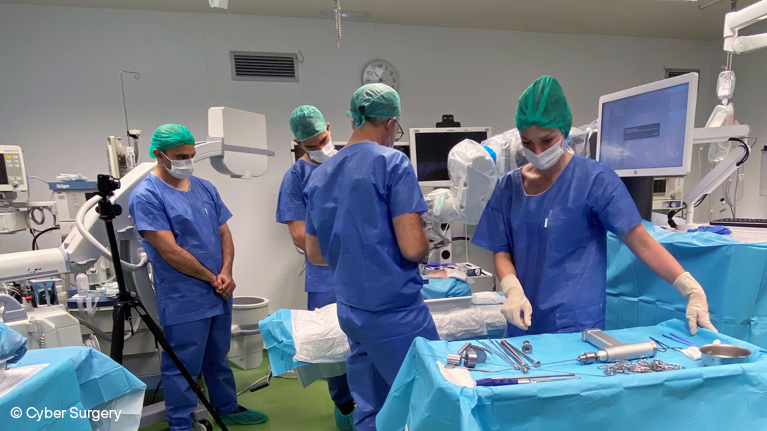How to optimise the accuracy of medical robots when performing complex surgery
Tekniker has developed an ad-hoc technological solution that has achieved a 50% improvement in the accuracy of a robotic system made by the start-up Cyber Surgery.

Robotics is revolutionising several sectors such as healthcare, for instance and, more specifically, some of its most complex surgical procedures. How it would it be possible to get these machines to achieve maximum levels of efficiency in operations that require a high degree of accuracy?
The Metrology and Precision Engineering Group of the Tekniker technology centre has developed a technological solution for the Gipuzkoa-based start-up company called Cyber Surgery that optimises the calibration and precision of a surgical robot used in backbone operations.
From a metrology perspective, the main challenge faced by the technology centre consisted in adapting and developing a measurement procedure used in mechatronic equipment to meet the needs of this robotic and medical application.
Una Mutilba, the Tekniker researcher in charge of the project explains that “compared to those used in the industry, this robot is smaller. The equipment, moreover, has been provided by Cyber Surgery which, compared to commercial robots, poses a number of challenges when the time comes to automating the measurement procedure”.
In order to respond to this challenge, the centre has developed a system based on laser tracker technology, a portable machine that makes it possible to perform coordinate spatial measurements and incorporates software developed ad-hoc by Tekniker to automate robot characterisation.
Unai Mutilba also states that “the measurement system and the robot communicate bidirectionally to manage the characterisation sequence and ensure that calibration data is suitable to improve accuracy at a later stage”.
A guide for surgery
Thanks to this technological solution, Tekniker has helped out with the calibration process of the Cyber Surgery robot and improved its precision by 50% so it can perform its task with regard to serving as a guide for surgeons when performing backbone operations.
More specifically, the equipment is based on previously planning the operation to be carried out by the surgeon by means of a user interface that allows screws to be selected and placed in the patient’s vertebrae. Once in the operating theatre, the Ciber Surgery robot guides the surgeon during the operation and helps to place screws according to previously defined trajectories.
The robot is equipped with a mechanical tracker that is connected to the patient’s vertebra. The robot places the instruments where they are required so that the surgeon may insert the screws according to the location and orientation defined beforehand. In this manner, the surgeon will be able to place the screws in the vertebrae according to pre-planned trajectories.
Tekniker has developed a solution that characterises and improves the accuracy of the robot when guiding the surgeon so that operations can be performed more accurately.
The utilisation of this assistant robot will significantly reduce invasiveness and achieve higher levels of medical accuracy. There will also be less X-ray exposure for patients and surgeons in addition to cost savings and shorter surgical sessions, as underscored by Cyber Surgery.
After obtaining the certification from the Spanish Agency for Medicines and Health Products (AEMPS), the equipment has successfully completed a clinical trial in patients from the University Hospital in Donostia-San Sebastián and the Cruces University Hospital in Bilbao, both part of the Basque Health Service (Osakidetza).
During the trial, the most common operation for the treatment of pathologies such as scoliosis, degenerative diseases or vertebral fractures, based on the placement of transpedicular screws, was performed.
The ultimate goal of this trial with patients is to certify the robot and market it in 2024.
